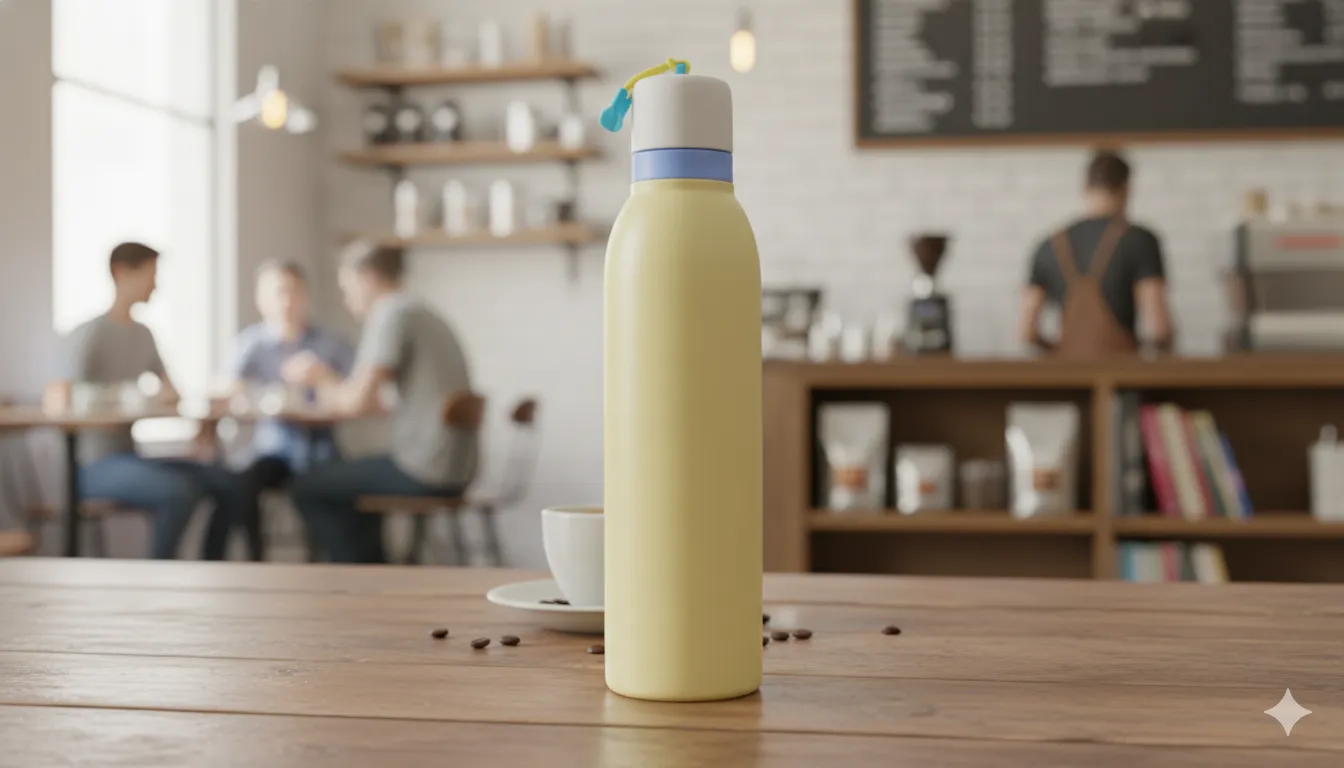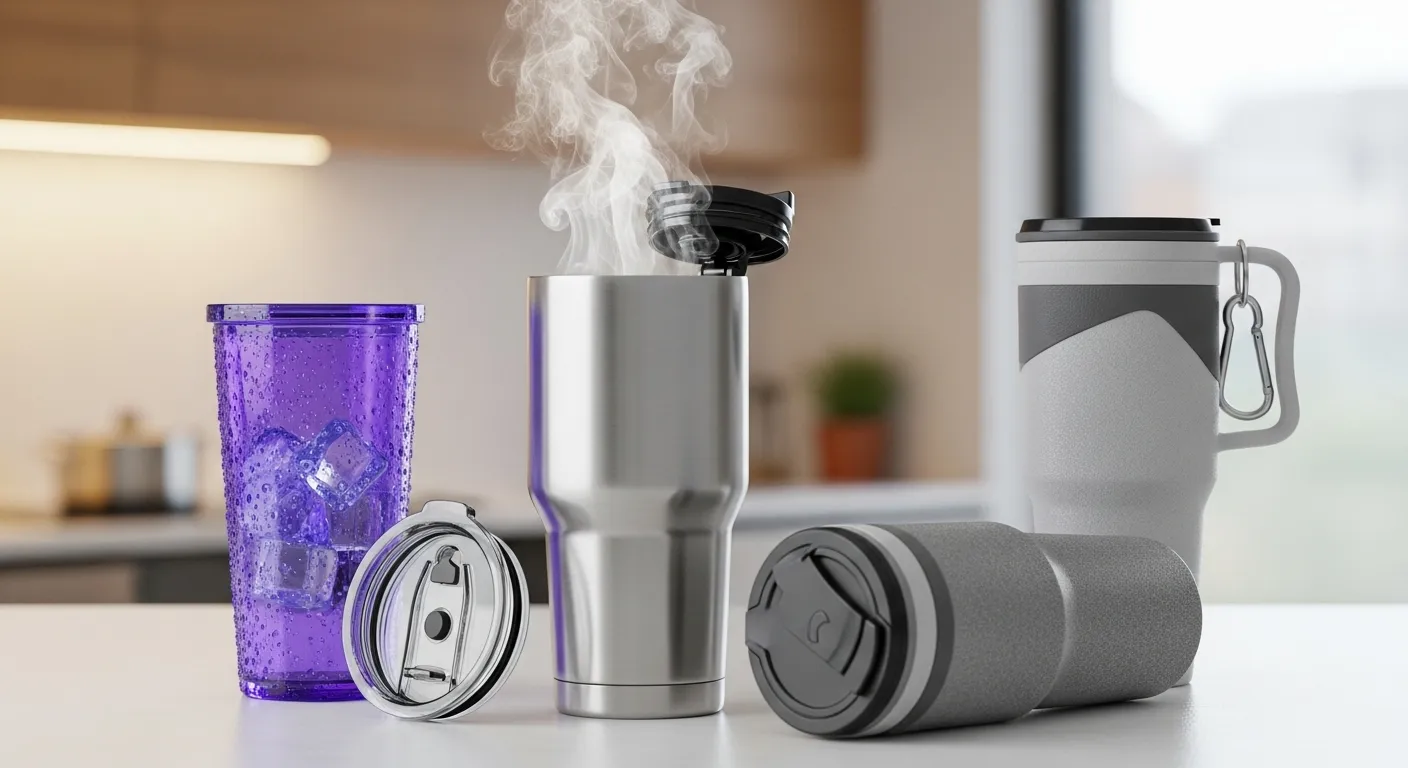
Blog
Decoding Tumbler Materials: Stainless Steel vs. Plastic vs. Glass for Durability & Safety

The Ultimate Tumbler Material Comparison: Finding Your Perfect Drink Companion
Ever find yourself staring at a wall of tumblers, wondering which one is actually right for you? It’s a common dilemma! Choosing the perfect daily companion involves more than just looks; it’s about understanding the tumbler material comparison.
Whether you’re a coffee connoisseur needing a morning boost, a hydration hero staying quenched all day, or just someone who needs their drink to stay hot or cold, the material of your tumbler makes a huge difference.
Today, we’re diving deep into the most popular options available for your daily sips. We’ll explore the pros and cons of materials like sturdy stainless steel tumbler designs, lightweight plastic tumbler options, elegant glass tumbler choices, and even classic ceramic tumbler styles.
Each of these materials brings its own unique set of benefits and drawbacks. We’re talking about things like durability for drops, safety for your health, and how long your drink actually stays at the desired temperature.
Our ultimate goal is to help you navigate these choices, so you can confidently pick the best tumbler material comparison for your lifestyle and enjoy every sip!
Unveiling the Top Contenders: A Deep Dive into Stainless Steel, Plastic, Glass, and Ceramic Tumblers
Time to meet the main contenders in our ultimate tumbler material comparison! Each option brings unique characteristics, making your choice truly personal.
First up is the hugely popular stainless steel tumbler. They’re everywhere for good reason – super durable, fantastic at insulating, and rust-resistant. Many prefer them for their long-lasting performance.
Then there’s the lightweight plastic tumbler. Think affordability, vibrant colors, and often shatter-resistance. They’re perfect for active lifestyles or a quick grab-and-go option that won’t weigh you down.
For pure taste, the glass tumbler is an excellent choice. No weird aftertastes! They look sleek, are easy to clean, and beautifully showcase your drink.
Finally, consider the comforting ceramic tumbler. Often seen as classic mugs, they also come as travel options. They offer a lovely drinking experience and reasonable heat retention, though careful handling is key. This sets the stage for our deeper tumbler material comparison!
The Essential Showdown: Comparing Each Material’s Thermal Performance, Durability, and Safety
Okay, now that we’ve met the contenders, let’s get down to business! This is where our tumbler material comparison really heats up (or cools down!). We’ll look at how each material stacks up in the key areas of thermal performance, durability, and safety.
When it comes to keeping your drinks just right, insulation is key. A stainless steel tumbler with double-wall vacuum insulation is the undisputed champion, holding temperatures for hours. Think piping hot coffee or ice-cold water all day long.
On the flip side, plastic tumblers and glass tumblers offer very little in the way of thermal retention. Your drink will reach room temperature fairly quickly. Ceramic tumblers provide decent heat retention, much like a traditional mug, but still can’t compete with insulated steel.
Now, let’s talk toughness. A stainless steel tumbler is incredibly durable, shrugging off drops and bumps like a champ. It’s built to last.
Plastic tumblers are generally shatter-resistant, making them great for kids or clumsy hands. However, they can scratch easily and sometimes absorb odors or stains over time. Glass tumblers and ceramic tumblers are the most fragile of the bunch. They’re prone to breaking if dropped, so handle with care!
Safety is always paramount. Food-grade stainless steel tumblers are wonderfully inert and won’t leach chemicals. For plastic tumblers, always ensure they are BPA-free for peace of mind, aligning with health recommendations.
Glass tumblers are also incredibly safe, as glass is non-porous and doesn’t interact with your drink. With ceramic tumblers, modern options are safe, but it’s good to ensure glazes are lead-free. This essential breakdown helps you in your ultimate tumbler material comparison!
Beyond the Basics: How Tumbler Materials Impact Taste, Weight, and Cleaning Effort

Beyond durability and safety, your tumbler’s taste, weight, and cleaning effort are crucial. These everyday details shape your sipping experience!
Quick Look: Taste, Weight, and Cleaning
- Taste Purity: For pure taste, glass tumblers and ceramic tumblers are unbeatable; they offer zero flavor interference. Quality stainless steel tumblers are neutral. Plastic tumblers sometimes impart subtle flavors, especially with hot liquids.
- Weight Factor: Plastic tumblers are lightest, ideal for portability. Stainless steel tumblers offer sturdy, mid-range weight. Glass tumblers and ceramic tumblers are generally heaviest, a key factor for on-the-go use.
- Cleaning Effort: Glass tumblers and ceramic tumblers are incredibly easy to clean, resisting stains and odors. Stainless steel tumblers are also straightforward. Plastic tumblers absorb flavors and stains, often needing more diligent cleaning.
Considering these aspects rounds out your tumbler material comparison, helping you find your ideal drink companion!
Solving Your Sipping Dilemmas: Best Tumbler Materials for Hot Beverages, Cold Drinks, and Active Lifestyles

Ready to make a choice? Let’s match the best tumbler material to your specific drinking habits and lifestyle!
For Hot Beverages:
- For maximum heat retention, a vacuum-insulated stainless steel tumbler is unmatched. It keeps drinks hot for hours.
- A ceramic tumbler offers a pure taste for hot drinks, but its insulation isn’t as robust as stainless steel.
For Cold Drinks:
- Once again, the stainless steel tumbler excels at keeping beverages ice-cold with minimal condensation.
- A glass tumbler is great for taste at home, but offers less temperature retention.
- For lightweight, short-term cold, a plastic tumbler is a fine choice.
For Active Lifestyles:
- Durability is paramount! A tough stainless steel tumbler handles bumps and drops perfectly for any adventure.
- A lightweight, BPA-free plastic tumbler is also a great, budget-friendly option for the gym or hiking.
- Avoid fragile glass tumbler or ceramic tumbler options; they won’t survive an active outing.
This practical guide should significantly help your tumbler material comparison and decision-making!
Making a Sustainable Choice: Considering Environmental Impact and Longevity of Your Tumbler
Let’s think green! When picking your tumbler, consider its environmental footprint and true longevity. This is a crucial part of any good tumbler material comparison.
So, for a solid look at sustainability, consider these points:
- Stainless Steel: A top eco-choice! Your stainless steel tumbler is super durable, lasts a lifetime, and is highly recyclable. This means far less waste overall.
- Glass: Infinitely recyclable, which is great. But a glass tumbler‘s fragility often means breakage and replacements, lowering its sustainable benefit.
- Plastic: Often problematic. Many reusable plastic tumbler options degrade faster and are difficult to effectively recycle. Much ends up in landfills.
- Ceramic: Durable if careful, but a ceramic tumbler can still break. Limited recycling means long-term, careful use is vital for sustainability.
Ultimately, the most sustainable choice is what you use consistently for years. Invest in quality, like a robust stainless steel tumbler, to significantly reduce waste. Choose longevity!
Frequently Asked Questions
Beyond temperature retention, are there specific drinks better suited for certain materials?
Absolutely! While stainless steel is fantastic for most beverages, some find that extremely acidic drinks (like strong lemon water) can sometimes take on a faint metallic taste if left for prolonged periods in lower-quality steel. Plastic, especially if it’s not high-grade or BPA-free, can absorb odors and flavors over time, making your morning coffee taste like yesterday’s smoothie. Glass, being non-porous and inert, is the champ for preserving pure taste – perfect for fancy teas or craft cocktails where flavor integrity is key.
How does the lid material impact the overall safety and performance of a tumbler?
Great question! The lid is often an unsung hero. Most modern lids are made from BPA-free plastics (like Tritan) or silicone. Plastic lids are common for their durability and seal, but always check for BPA-free labeling. Silicone gaskets and straw components are excellent because they’re flexible, provide a tight seal, and are generally very inert, meaning they won’t react with your drink or impart flavors. A poor-quality lid, regardless of your tumbler’s body material, can lead to leaks, taste transfer, and even harbor bacteria if not cleaned properly. So, always consider the lid’s quality and material!
Are there any innovative or emerging tumbler materials we should know about?
The world of materials is constantly evolving! While stainless steel, plastic, and glass remain dominant, we’re seeing some exciting innovations. Borosilicate glass (a more durable, thermal-shock-resistant type of glass) is becoming more popular for its strength. Some brands are experimenting with plant-based plastics or recycled materials, aiming for greater sustainability. You might also encounter double-walled ceramic tumblers, which offer excellent insulation with a luxurious feel, though they can be heavier and more fragile than stainless steel. Keep an eye out for these specialized options!
Considering environmental impact, which tumbler material is the most sustainable choice?
This is a complex but crucial question! Generally, the most sustainable tumbler is the one you use consistently for years, regardless of material, as it replaces countless single-use cups. However, if we look at the materials themselves:
- Stainless steel is highly durable and 100% recyclable, making it a great long-term choice. Its production has an initial energy cost, but its longevity usually outweighs this.
- Glass is also highly recyclable and made from abundant natural resources. Its main environmental drawback is its weight, which increases shipping emissions, and its fragility leading to potential replacements.
- Plastic (virgin plastic) has the highest environmental footprint due to its reliance on fossil fuels and often limited recyclability (though recycled plastics are better).
The best choice is often a durable, high-quality tumbler you love and will keep out of landfills for a very long time, ideally made from recyclable materials. Ultimately, mindful consumption trumps individual material choice!
